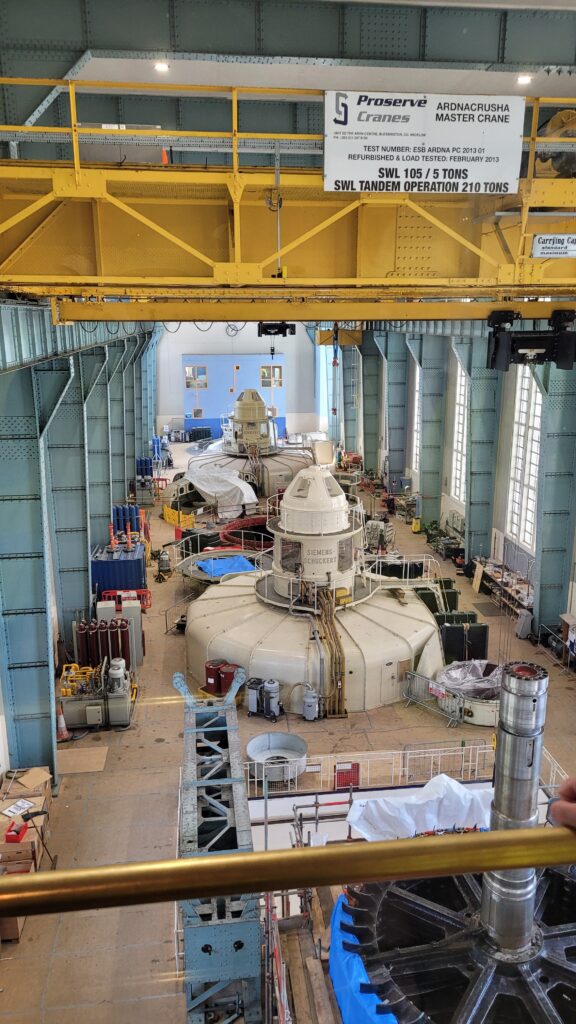By Claire Graham

A newspaper snippet piqued my interest—free tours of the nearly 100-year-old Ardnacrusha hydroelectric station. A niche passion, perhaps, but hydro stations and I go way back. Cathleen’s Fall, Ballyshannon, Co. Donegal (see Reviews, pp 64–5), where my father worked, was my childhood stomping ground. I made a booking. Fast-forward to a warm August day in east Clare. The Ardnacrusha complex is large, lawned, sculpted and dominated by a central edifice—more train station than power station. I join our guide and group, don protective gear and we’re off. First stop the said building. Built between 1925 and 1929, the station was given a Germanic-effect exterior in deference to the Siemens Schuckert designers. It is now a protected structure owing to its pioneering use of concrete and steel.
An audiovisual space inside offers us an overview with facts, figures, footage and photos. Our guide explains that in 1922 an Irish engineer called Thomas McLaughlin returned to Ireland after working with Siemens Schuckert in Berlin. He suggested that hydroelectric power was the only realistic energy-generating option for the nascent state. His vision included diverting the River Shannon and building a hydroelectric power station. Ardnacrusha was the proposed site.
In 1923 McLaughlin, along with TD Patrick McGilligan (minister for industry and commerce), persuaded the new government to consider his ambitious Shannon Scheme proposal. Siemens presented a report outlining the design and the economic justification. The White Paper that resulted in 1924 was reviewed and accepted in spring 1925. The Shannon Electricity Bill was passed by the Dáil in June 1925 and the contract for delivery was awarded to Siemens in August—a veritable whirlwind of political activity and decision-making!
Work began almost immediately. The budget of £5.2 million was a whopping 20% of Ireland’s national revenue for that time. Construction took a mere four years, and approximately 4,000 Irish and 1,000 Germans worked and lived on site or locally. The work was dirty and dangerous. Irish labourers were paid the going agricultural rate; 13-hour days were the norm, night shifts mandatory. Rations were basic—one main meal a day supplemented by two others of bread and butter. Accommodation was scarce and of poor quality. An innovative solution saw a scramble for the wooden packing cases when machinery was delivered, which, our guide admitted, was probably an upgrade! The (mostly skilled) German contingent fared better; they lived in a purpose-built camp, moved their families in and even set up a German school.
We move outdoors and up 80+ steps. We spread out along the 30m-high dam wall; the head-race canal vista is to our left, stretching 12.6km to Parteen; the massive, heavily bolted penstocks, 4m x 6m wide and 41m long, slant down 32m to our right. Ahead is a boat channel with a double-chambered lock that drops 34m, one of the deepest canal locks in the world. To the front are the fish lifts (for salmon returning to spawn), a series of cylindrical cages. The adjacent ramps with bushy bristles are elver (baby eel) escalators to move them upstream. South-west is the rushing tail-race, where the water is disgorged from the turbines.
Ardnacrusha was the largest hydroelectric scheme in the world until overtaken by the Hoover Dam in the 1930s. When built, the station had a capacity of 86MW, providing 80% of the country’s electricity needs at the time. Today its four turbines represent only 2% of the ESB’s installed capacity but, looking down into the turbine hall, the group seem quietly awed. A deep inhalation now: that smell of industrial oil and damp concrete, along with the rhythmic ‘thrum’ of the turbines, strikes a nostalgic chord. The old control room, perched in the apex of the building, by contrast feels hallowed. Could anyone know what every gauge, switch and dial is for? At every ‘Do Not Touch’ notice I feel an involuntary twitch to disobey.
The Art Gallery is our next surprise. The artist Seán Keating was commissioned in 1926 to visually record the Shannon Scheme. He went for total immersion, living with the workmen on site and producing a series of 26 pieces, including his iconic Night’s Candles Are Burnt Out (Hunt Museum, Limerick), which uses the power station’s construction as an allegory for Ireland’s societal and technological advancement in the early twentieth century.
The Media Room, our final stop, is home to a fine display of old household appliances, bits of electrical hardware and a collection of persuasive posters extolling the benefits of electrification. ‘The housewife’ is the clear target, which wouldn’t wash (sorry!) today, but they do offer a fascinating social snapshot of pre-electrification Ireland. This ‘up-close-and-personal’ tour is expertly delivered by guides who really know their stuff. Tours finished in September but will resume in July 2026.
Further information: www.esb.ie/ardnacrushatours.
Claire Graham is a freelance business mentor and journalist.
